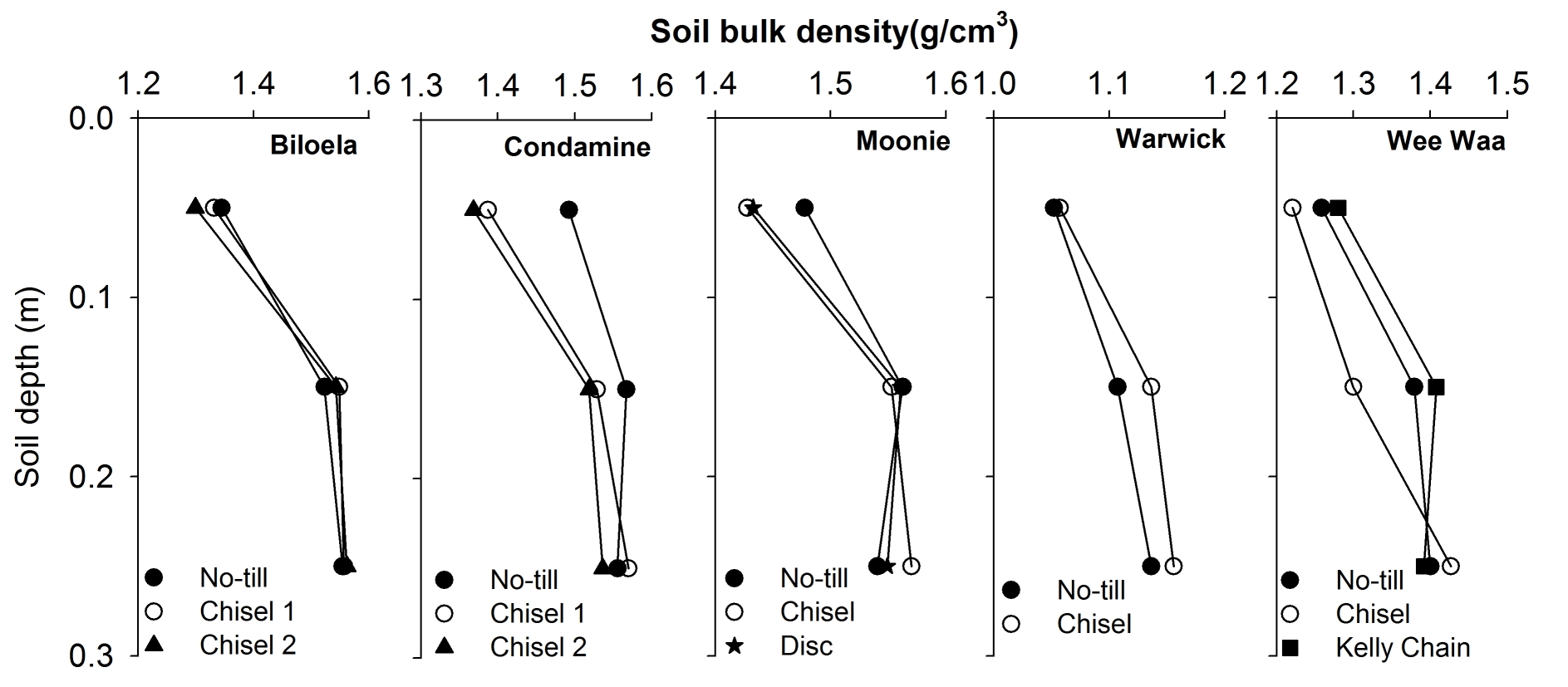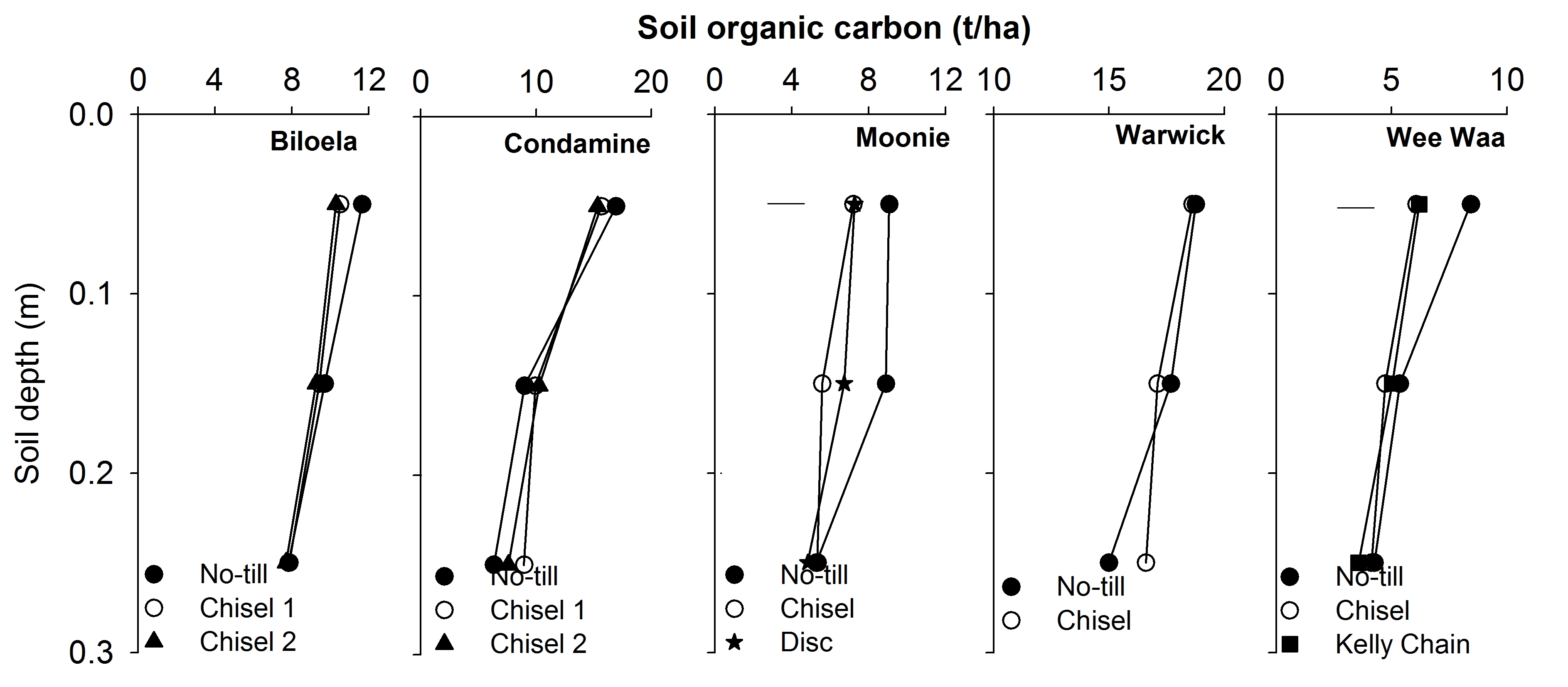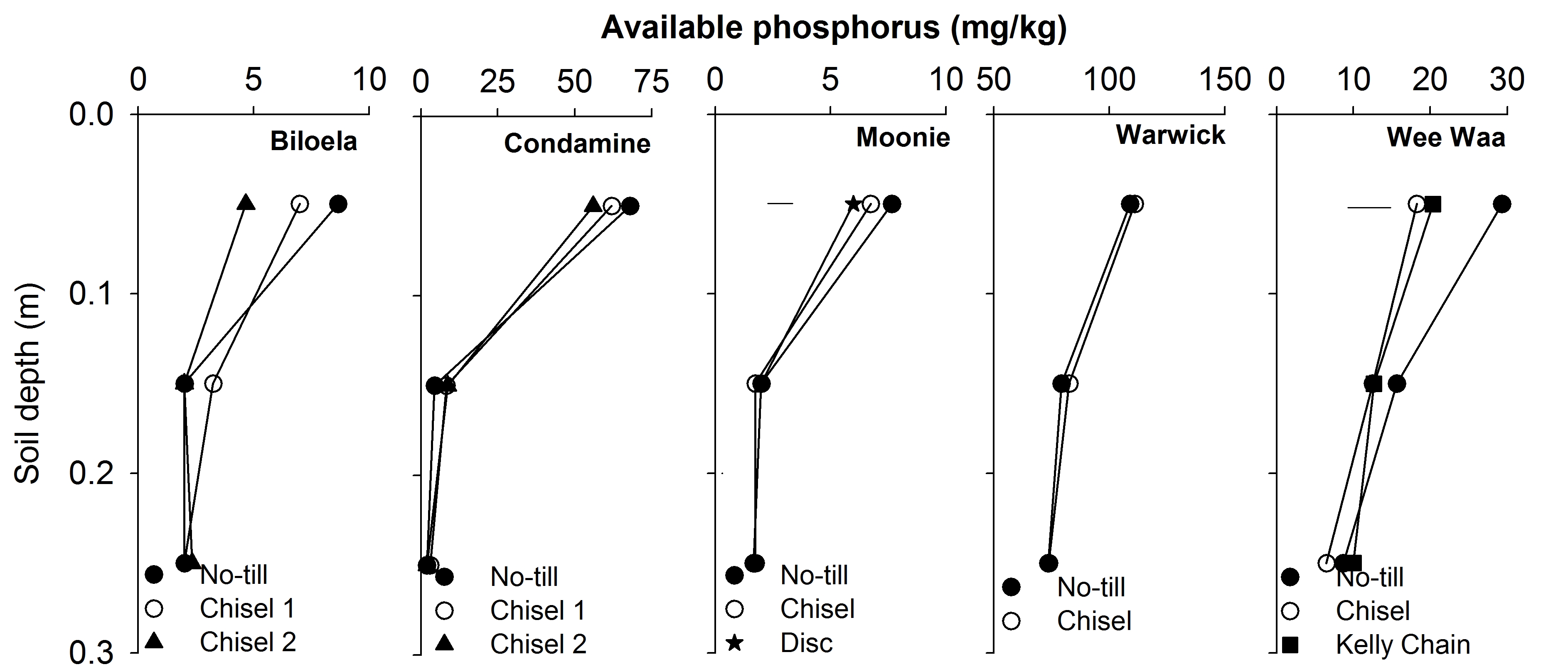Tillage impact in long term no-till
Tillage impact in long term no-till
Author: Yash Dang, Vivian Rincon-Florez, Clement Ng, Suzette Argent, Mike Bell, Ram Dalal, Phil Moody and Peer Schenk | Date: 27 Feb 2013
Yash Dang1, Vivian Rincon-Florez2, Clement Ng2, Suzette Argent3, Mike Bell2, Ram Dalal1, Phil Moody1 and Peer Schenk2
1Queensland Department of Science, Information Technology, Innovation and the Arts
2Queensland Alliance for Agriculture and Food Innovation
3Queensland Department of Agriculture, Fisheries and Forestry
Take home message
One-time tillage with chisel or offset disc in long-term no-till helped control winter weeds, slightly improved grain yields and profitability while retaining many of the soil quality benefits of no-till farming systems. Tillage reduced soil moisture at most sites; however, this decrease in soil moisture did not adversely affect productivity. This could be due to good rainfall received between tillage and prior to seeding and during the crop this year. The occurrence of rain between the tillage and sowing or immediately after the sowing is necessary to replenish soil water lost from the seed zone. This suggests importance of timing of tillage and taking seasonal forecast into consideration. Future research will determine best timing for strategic tillage in no-till.
Introduction
The benefits of no-till systems are widely known and have been for many years – with significant benefits in yield and crop performance especially in lower rainfall environments, erosion control and improved soil health. No-till has revolutionized agricultural systems by allowing growers to manage greater amounts of land with reduced energy, machinery and labour inputs. Despite these tangible benefits, recent survey of 55 growers and advisors in the northern grains region indicated that diseases such as crown rot and yellow leaf spot and hard-to-kill weeds such as fleabane, feathertop Rhodes, windmill grass and glyphosate resistant barnyard and liverseed grass, tend to be bigger problems in no-till systems than in systems where tillage is regularly used. Further, recent wet seasons have favoured disease and weed development in no-till farming systems and have put pressure on grower’s management strategies to combat heavy infestations of weeds and diseases. Issues with cost effective management of glyphosate tolerant or resistant weeds has led to an increasing number of growers and their advisors to seriously consider the merits of re-introducing the plough in certain situations (Heath 2011). However, many growers are concerned that even a single tillage operation may be enough to send their soil conditions back to the start of conservation farming systems. Many growers are keen to know what would be the level of impact of occasional tillage in no-till farming systems on their soil health and production system.
What was done in 2012?
From the northern grains region, we selected five fields on long-term no-till farming systems. These fields were located near the towns of Biloela, Condamine, Moonie, Warwick and Wee Waa. At all sites except Warwick, experimental design was a randomised complete block with four replications. Plot size was a minimum of 100 m length and width of permanent controlled traffic tramline. All sites received tillage treatments to the depths of between 15 and 20 cm (chisel tillage, and/or offset disc or Kelly chain) at least once in March 2012. At the Biloela and Condamine sites, a second tillage was applied in 3rd week of April 2012. At the Warwick long-term tillage experiment, a factorial combination of (2 tillage; conventional or no-till x 2 crop residue management; retained or burned x 3 N rates; 0, 30 or 90 kg N/ha) with four replications was applied. In 2012, each plot was longitudinally split in two; half receiving chisel tillage in March 2012 and half was left untilled. However, in the present report we will present results only for no-till, stubble retained plots. Detailed site and tillage information is given in Table 1.
Table 1: Detailed site and experiment description
|
|
Biloela |
Condamine |
Moonie |
Warwick |
Wee Waa |
|---|---|---|---|---|---|
|
No-till history (yrs) |
18 |
19 |
7 |
44 |
16 |
|
Previous crop |
Wheat |
Wheat |
Wheat |
Wheat |
Chickpea |
|
Specific issues |
Sowthistle, Fleabane |
Fleabane |
Fleabane, Rhodes grass |
Wild oat, Crown rot |
Crown rot, Turnip weed |
|
Date of tillage I |
29.03.12 |
06.03.12 |
03.03.13 |
07.03.12 |
26.03.12 |
|
Date of tillage II |
20.04.12 |
18.04.12 |
- |
- |
- |
|
Tillage implements |
Chisel |
Chisel |
Chisel, Offset disc |
Chisel |
Chisel, Kelly Chain |
|
Crop 2012 |
Wheat |
Chickpea |
Barley |
Wheat |
Wheat |
|
Clay (%) 0-10 cm |
50 |
25 |
38 |
65 |
52 |
|
Soil type |
Vertosol |
Duplex |
Hard setting |
Waco |
Vertosol |
|
Rainfall between tillage I & sowing |
25 |
81 |
80 |
118 |
91 |
|
Rainfall between tillage II & sowing |
25 |
51 |
- |
- |
- |
|
In-crop rain (mm) |
145 |
205 |
111 |
122 |
95 |
A minimum of two locations were randomly selected for soil sampling per plot. Two soil samples were taken per location during May-June 2012, using a 50-mm diameter tube and a hydraulic sampling rig. The soil core was sectioned into 0-0.1 m, 0.1-0.2 m and 0.2-03 m depths. The first replication of soil cores was dried at 105ºC to obtain bulk density from the mass of oven-dried soil contained in a given volume of the soil sample. The second replication of soil cores was dried at 40ºC and ground to pass through a 2-mm sieve for available P. A sub-sample from the second replication was ground to pass through <0.25 mm sieve for soil organic carbon. For total soil microbial activity, five soil samples were collected to a depth of 0.05 m using hand shawl and composited and analysed for total soil microbial activity using fluorescein diacetate (FDA). During the crop growth, between July and August, weed density was measured using a 0.25-m square steel frame randomly placed at four locations in each plot and number of individual plants inside the frame recorded.
Results so far
Weed density
Most common in-crop weeds included sowthistle (Biloela, Condamine), fleabane, turnip weed, sowthistle (Moonie), wild oats (Warwick) and turnip weed (Wee Waa). Imposition of one time tillage significantly reduced weeds densities in no-till farming systems at all the sites (Table 2). Imposition of the second tillage at Biloela and Condamine sites further significantly lowered weeds densities. Differences between tillage implements viz. chisel and offset disc at Moonie site and chisel and Kelly chain at Wee Waa site were not significantly different.
Table 2: Average weed population (number/m2) within crop after imposition of tillage in long-term no-till systems
|
|
Biloela |
Condamine |
Moonie |
Wee Waa |
|---|---|---|---|---|
|
No-till |
10.5 |
14.5 |
9.2 |
4.3 |
|
Chisel 1 pass |
4.2 |
6.5 |
1.0 |
0.7 |
|
Chisel 2 passes |
1.2 |
2.2 |
- |
- |
|
Offset disc |
- |
- |
1.2 |
- |
|
Kelly chain |
- |
- |
- |
1.5 |
|
LSD 5% |
1.7 |
2.8 |
3.2 |
1.3 |
Soil bulk density and moisture
The bulk density of soil in the top 0.1 m depth was not significantly affected by the imposition of tillage, however, tillage tended to decrease soil bulk density at all sites except at Warwick (Fig. 1).

Figure 1: Bulk density of soil 3 months after imposition of tillage treatments in long-term no-till systems.
No significant differences in soil moisture content due to tillage treatments were observed prior to seeding in the winter season of 2012 (Fig. 2). All sites except Biloela received >80 mm rainfall after the imposition of tillage and prior to seeding. This compensated for the loss of soil moisture due to higher evaporation rate of tilled soil being rapidly desiccated at the surface. At the Biloela site, there was substantial loss of moisture due to very low rainfall after imposition of tillage and prior to seeding. However, at the Warwick site, in-spite of 118 mm rainfall received after tillage and prior to seeding, there was substantial loss of moisture from the top surface soil to 0.1 m depth which could be due to high clay contents (Table 1) of the soil requiring more rain to refill soil profile.

Figure 2: Soil moisture contents in soil 3 months after imposition of tillage in long-term no-till systems.
Soil organic carbon and available phosphorus
One or two cycles of tillage treatments had no significant effect on soil organic carbon mass at Biloela, Condamine and Warwick sites, however, at Moonie and Wee Waa sites, one-time tillage either with chisel or disc or Kelly chain significantly reduced the soil organic carbon in the surface 0-0.1 m soil depth (Fig. 3). Differences between different tillage implements were not significant.

Figure 3: Soil organic carbon mass in soil 3 months after imposition of tillage in long-term no-till systems. Horizontal lines indicate LSD at P=0.05 within a site.
Overall, one time tillage tended to lower available P in the surface 0-0.1 m soil depth at all sites, however, the differences were significantly different only at Moonie and Wee Waa sites (Fig. 4). The differences between chisel and disc at Moonie site or between chisel and Kelly chain at Wee Waa were not significantly different. The second cycle of tillage at the Biloela and Condamine sites further lowered the available P in the surface 0-0.1 m soil depth; however, the differences were not significant between no-till and first or second cycle of tillage.

Figure 4: Available P (Colwell-P) in soil 3 months after imposition of tillage in long-term no-till systems. Horizontal lines indicate LSD at P=0.05 within a site.
Soil microbial activity
One or two passes of tillage did not significantly affect the total microbial activity at all sites except for Warwick and Biloela (Table 3). At the Warwick site, imposition of one-time tillage significantly decreased microbial activity. On the other hand, one-time tillage showed significantly higher activity than the no-tillage treatment at the Biloela site. Total microbial activity was not significantly different with different tillage implements such as chisel or offset disc at Moonie and chisel or Kelly chain at Wee Waa.
Table 3: Total microbial activity (µg/ml FDA/g of soil/hour) in soil 3 months after imposition of tillage in long-term no-till system
|
|
Biloela |
Condamine |
Moonie |
Warwick |
Wee Waa |
|---|---|---|---|---|---|
|
No-till |
1.18 |
1.80 |
0.90 |
2.01 |
2.8 |
|
Chisel 1 pass |
1.59 |
1.63 |
0.71 |
1.54 |
2.6 |
|
Chisel 2 passes |
1.98 |
1.92 |
- |
- |
2.4 |
|
Offset disc |
- |
- |
0.91 |
- |
- |
|
Kelly chain |
- |
- |
- |
- |
- |
|
LSD 5% |
0.003 |
NS |
NS |
0.04 |
NS |
Productivity
Grain yields showed little response to tillage (Table 4). One-time tillage using either chisel or offset disc tended to increase grain yields at all the sites but only significantly at the Condamine site. A second tillage pass did not further improve the grain yield either at Biloela or Condamine sites. Kelly chain had no effect on grain yield.
Table 4: Impact of tillage imposition on grain yield (t/ha) in long-term no-till systems
|
|
Biloela1 |
Condamine2 |
Moonie3 |
Warwick 1 |
Wee Waa1 |
|---|---|---|---|---|---|
|
No-till |
2.66 |
1.05 |
2.27 |
2.75 |
1.46 |
|
Chisel 1 pass |
2.75 |
1.14 |
2.42 |
2.85 |
1.54 |
|
Chisel 2 passes |
2.72 |
1.16 |
- |
- |
- |
|
Offset disc |
- |
- |
2.37 |
- |
- |
|
Kelly chain |
- |
- |
- |
- |
1.46 |
|
LSD 5% |
NS |
0.06 |
NS |
NS |
NS |
1Wheat grain; 2Chickpea grain; 3Barley grain
Profitability
Net returns per hectare from one-time tillage using either chisel or offset disc in long-term no-till systems were estimated to range from $2.5 to $35.8 (Table 5). The highest net return was obtained at the Condamine site, which could be the result of higher chickpea prices. A second tillage pass at Biloela and Condamine did not further increase net returns. Among tillage implements, chisel tillage resulted in higher net returns than offset disc at Moonie site, and similarly chisel tillage gave better returns than Kelly chain at Wee Waa.
Table 5: Profitability ($/ha) of tillage imposition in long-term no-till systems
|
|
Biloela |
Condamine |
Moonie |
Warwick |
Wee Waa |
|---|---|---|---|---|---|
|
Chisel 1 pass |
2.5 |
32.8 |
22.6 |
11.1 |
6.9 |
|
Chisel 2 passes |
-3.7 |
31.1 |
|||
|
Offset disc |
10.7 |
||||
|
Kelly chain |
-10.0 |
Wheat grain, $280/t; Chickpea grain, $550/t; Barley grain, $260/t; Cultivation-Chisel or Offset disc, $15/ha; Kelly Chain, $10/ha
Implications
Tillage treatment generally slightly lowered bulk density, soil moisture prior to seeding, soil C and available P in the surface 0-0.1 m soil depth. Significant negative effect of one-time tillage on soil organic carbon and available P at the Moonie and Wee Waa sites and total soil microbial activity at Warwick site did not result in adverse effects on productivity and profitability. One potential negative effect from tillage is the reduced soil moisture at most sites. However, in this season this decrease in soil moisture did not adversely affect productivity. This could be due to good rainfall received between tillage and prior to seeding and during the crop this year. This suggests the importance of timing of tillage and taking seasonal forecast into consideration.
It is also important to note that at all sites in this season, all tillage operations were conducted later in the summer fallow period i.e. after March 3rd. Tillage earlier in the fallow period could have had a far greater impact on fallow efficiency and water storage for the following crop.
References
Heath, R., 2011. Conservation Agriculture: have the good years become the bad years? Proceedings of the 5th World Congress of Conservation Agriculture, Brisbane 26-29 September 2011, 1-2.
Acknowledgements
We are indebted to our collaborative growers, Darren Jensen, Nev and Ron Boland, Rod and Sam Hamilton and Ken Stump for providing field sites, managing the experiments, and providing their generous support. We thank the Grains Research and Development Corporation for partial funding of this study. Thanks are also due to Darren Aisthorpe, Greg Rummery, Sarah Groat, Tim Weaver, Don Browne, Graham Pauli, Steven Reeves, Denis Orange, Tony King, Maria Harris, Brad Oleksyn and Rod Obel for their help with soil sampling and various field operations.
Contact details
Dr Yash Dang, Senior Scientist (Soil and Nutrient Management)
Queensland Department of Science, Information Technology, Innovation and the Arts
Ph: 07 4529 1245
Fx: 07 4529 1564
Email: Yash.Dang@science.dsitia.qld.gov.au
Reviewed by
John Cameron
GRDC Project Code: ERM00003 Does strategic tillage undo long term improvement in soils under no-till?,
